
Q&A: The evolving debate about using genetically modified crops in a warming world
Orla Dwyer
05.22.24Orla Dwyer
22.05.2024 | 1:58pmCrops that have been “altered” by scientists in a laboratory can be found growing on millions of hectares of farmland around the world.
These “genetically modified organisms” (GMOs) are planted extensively across swathes of North and South America, in particular, but remain strictly limited in many countries.
However, these stringent regulations have eased in some nations for crops altered using new, more precise “gene-editing” technologies.
Several experts tell Carbon Brief that these new technologies are not a “silver-bullet” solution for agriculture, but that they could help crops deal with extreme weather and boost nutrition in a faster, safer and cheaper way than GMOs.
In contrast, other experts, as well as environmental groups, are concerned about how these gene-edited crops will be produced, regulated and patented.
In this Q&A, Carbon Brief looks at the difference between GMOs and gene-edited foods and whether these technologies can help crops deal with climate change while boosting food security.
- What are genetically modified crops?
- Where are genetically modified and gene-edited crops grown around the world?
- What are the perceived benefits and concerns of genetically engineered foods?
- Could gene-editing and GMOs benefit food security?
- Do genetically modified crops benefit climate mitigation and adaptation?
What are genetically modified crops?
For centuries, farmers have used selective breeding techniques to prioritise growing crops with desirable traits, such as resistance to disease.
In the 1970s, scientists developed new ways to boost these traits directly by changing a plant’s genetic material.
GMOs – genetically modified organisms – are plants, animals and microorganisms whose genes have been altered with the help of technology.
Dr Jennifer Pett-Ridge is a senior researcher at the Lawrence Livermore National Laboratory and principal investigator on a soil carbon project at the Innovative Genomics Institute in Berkeley, California.
She explains that gene modification technologies take DNA from one species and insert it into another. She tells Carbon Brief:
“It might be a frog or a tomato, or something like that, that you’re importing from another organism that has a trait that you really want that will work within your organism of choice. You’re splicing that in, essentially.”
The most common traits scientists put into genetically modified crops include tolerance to weed-killing herbicides and resistance to insects and viruses. The techniques can also be used to develop plants that are better able to deal with drought, heat and other intensifying effects of climate change.
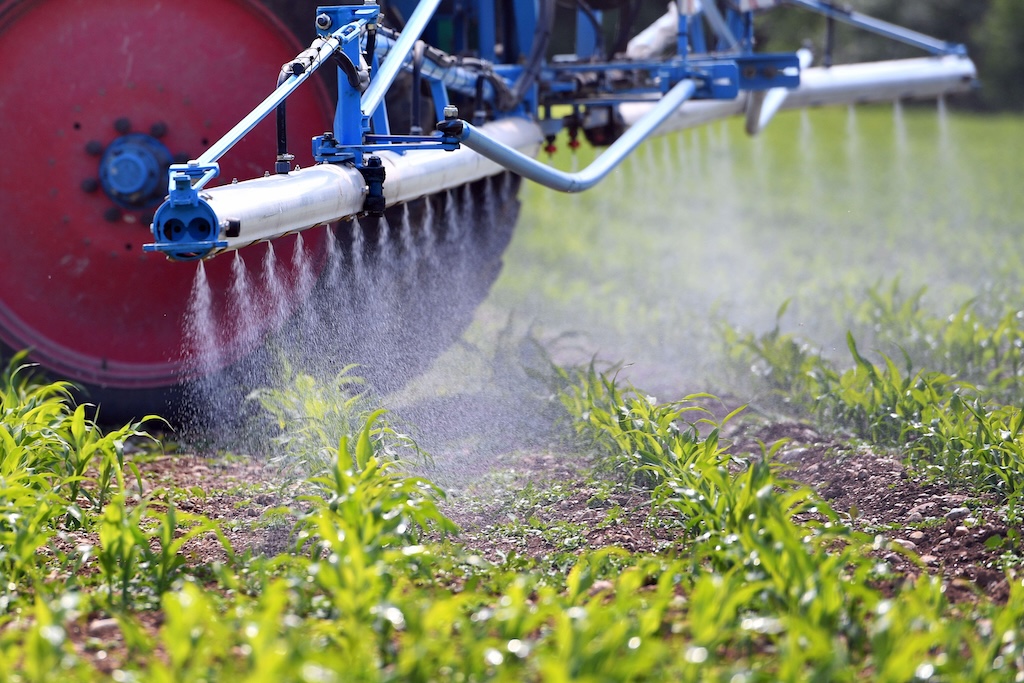
In the US in 1994 – after years of testing and experiments – a GM tomato was the world’s first genetically engineered food sold in shops, according to the country’s Food and Drug Administration (FDA).
This tomato was “genetically altered to ripen longer on the vine while remaining firm for picking and shipping”, the New York Times reported at the time.
Two years later, farmers began growing genetically engineered crops across the US. One example is “Roundup Ready” maize, cotton and other crops. These plants were developed by the chemical company Monsanto – which was bought out by Bayer in 2018 – to be more resistant to the weed-killer Roundup.
A gene that is resistant to glyphosate – the herbicide used in Roundup – was taken from a type of bacteria and inserted into these crops. This, in turn, allowed farmers to apply the herbicide to kill weeds without destroying their crops.
In more recent years, scientists have developed different ways to alter DNA. One prevailing method is Crispr/Cas9 – a gene-editing technology that can tweak genetic code without needing to introduce traits from another species. The scientists behind the discovery were awarded a Nobel Prize in 2020.
The method is akin to using a “pair of scissors to just snip a gene out and move it somewhere else” within the same plant, Pett-Ridge says, preventing the need to mix in DNA from other species, which is how GMOs are made.
For example, the technology could be used to remove a gene that makes a plant less able to deal with drought.
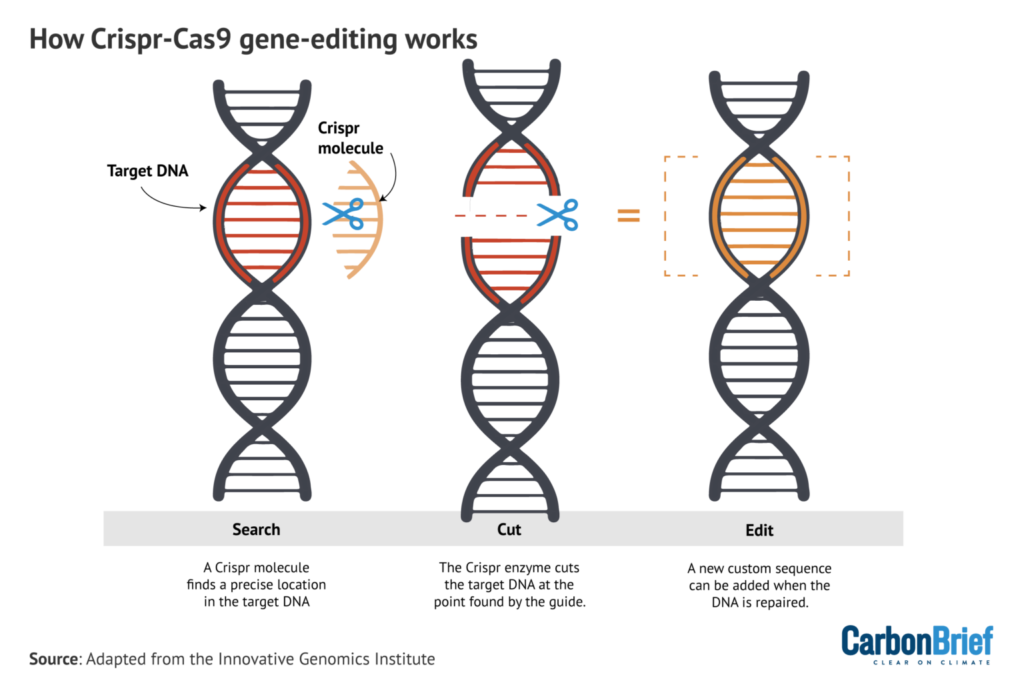
A 2016 study on the possibilities of Crispr for plants described the technology as relatively simple, cheap and versatile compared to other methods. So far, scientists have carried out studies on the method’s ability to alter the genetic make-up of a wide range of crops, from rice and tomatoes, to oranges and maize.
However, these trials are in the early stages of development and experts tell Carbon Brief more research is needed before they are widely commercially available.
New technologies such as Crispr are being regulated differently to other GMOs in many countries, but opinions differ on how different they truly are from older genetic-engineering techniques.
Although there is limited evidence showing that GMOs have a negative effect on human health and the environment, they remain controversial for many due to concerns over reduced biodiversity and the prevalence of crop monocultures.
Where are genetically modified and gene-edited crops grown around the world?
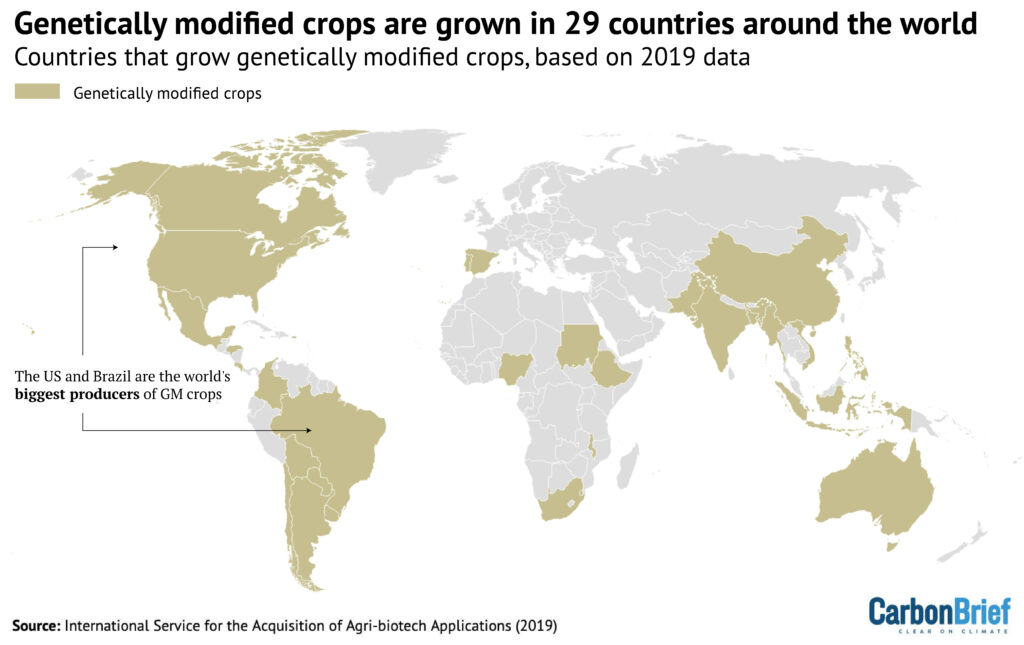
Genetically modified crops are widely grown in some parts of the world, such as the US and parts of South America, and are more restricted in the EU and many African countries.
In 2019, more than 190m hectares of genetically modified crops were planted around the world – an area roughly the size of Mexico – according to the International Service for the Acquisition of Agri-biotech Applications.
In 1996, around the time GM crops were being approved for commercial use in several countries, this figure stood at 1.7m hectares.
The US grows the most GM crops of any country, followed by Brazil, Argentina, Canada and India – as shown in the figure below.
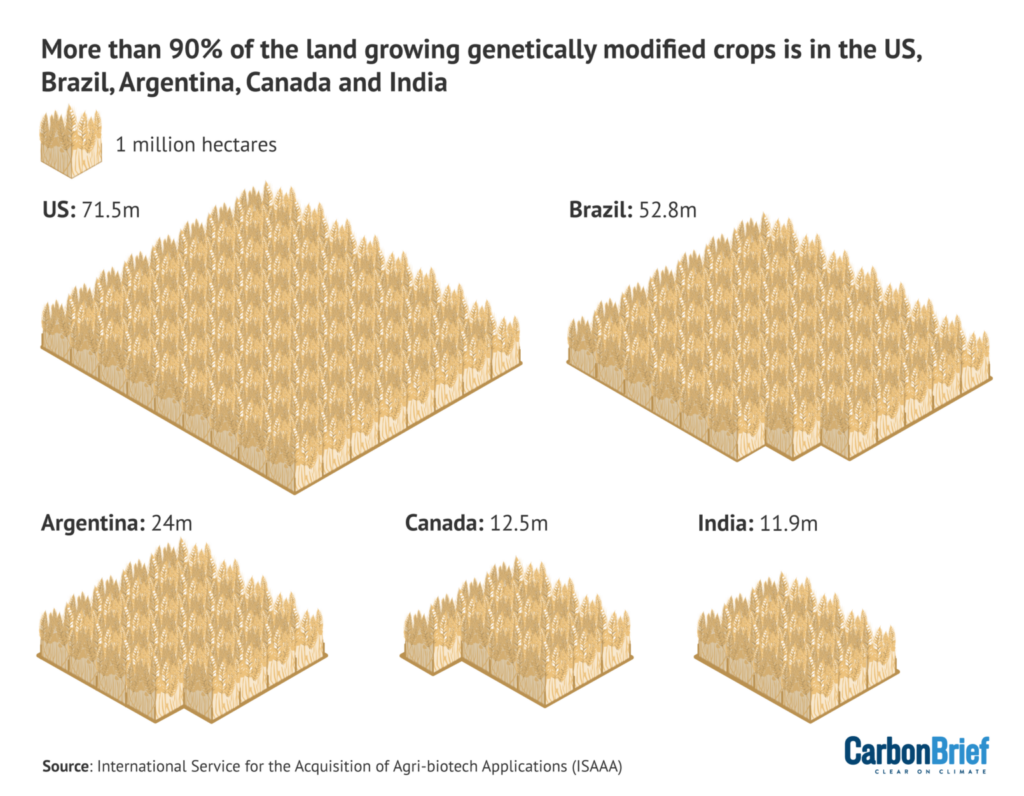
Almost all soya beans, cotton and maize now planted in the US are genetically modified, often to resist pests or deal with herbicide use, according to the FDA.
Alongside feeding people, GM maize and soya beans are frequently used to feed animals. More than 95% of livestock and poultry in the US eat genetically modified crops, the FDA says.
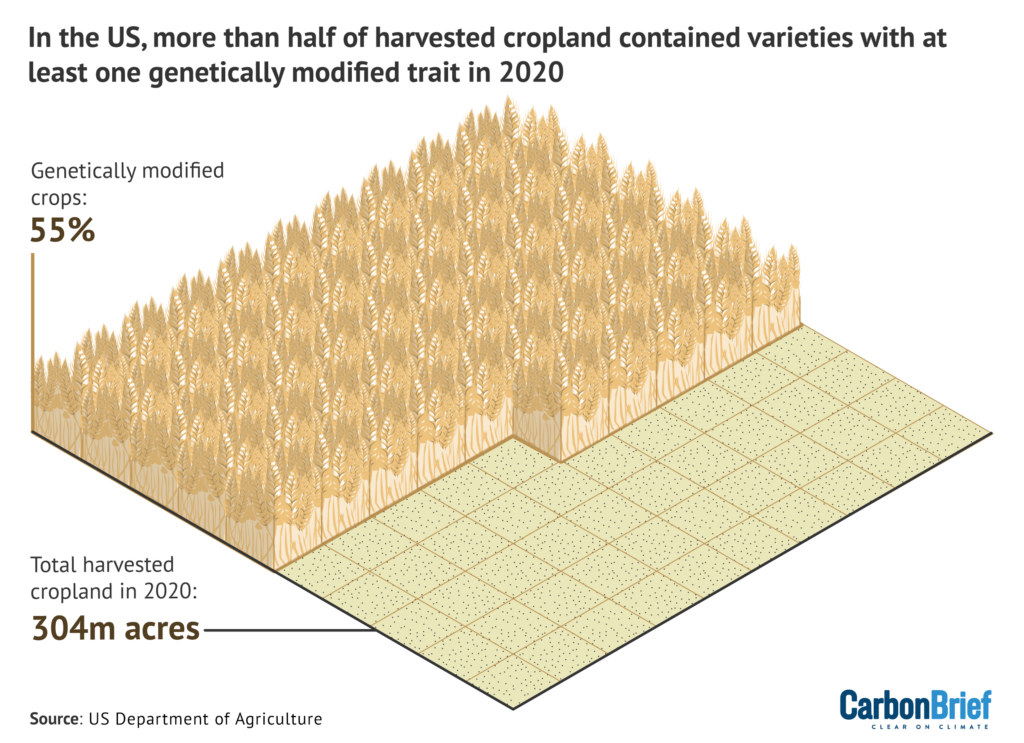
In the EU and other parts of the world, GM crops are not widely grown. The EU’s rules require GMO foods to be labelled as such for consumers and permit individual EU countries to ban genetically modified crops, if they choose. Most EU countries do not grow GMO crops.
The EU’s GMO rules still apply in the UK. But, in 2023, the rules in England were eased to allow the development of plants that are genetically edited using modern methods such as Crispr.
Further laws are needed to allow these gene-edited plants – and, later, animals – to be sold in England. The legislation for plants is set to be brought in this summer.
Rules around whether these gene-edited plants should be treated the same as, or differently to, GMOs are still being assessed by many governments around the world.
In some countries, such as the US, they are essentially treated the same as non-GMO products. Since they do not contain “foreign” genes, they are seen as indistinguishable from conventional plants.
The EU could be moving in a similar direction with a proposal from the European Commission to loosen its stringent GMO requirements for plants that have been made using newer gene-editing technologies.
The changes would “better reflect the different risk profiles” of the way in which gene-edited plants are made compared to genetically modified ones, the commission said.
Dr Ludivine Petetin, a reader in law and expert in agri-food issues at Cardiff University, says the proposal marks a significant change from the EU’s previous attitude to genetically altered foods.
If approved, the EU would create two categories of plants that have been altered by new genomic techniques. One category of plants would be considered comparable to conventional plants and would not require any GMO labelling for consumers.
Plants that have been made using these newer techniques, but do not meet this criteria, would fall into the second category. This would require stricter assessment and mandatory labelling, similar to how GMOs are currently regulated in the EU. Petetin tells Carbon Brief:
“That’s a massive, massive difference to the precautionary principle used before, where it was all about the need to inform the public – the need to tell them whether there is [genetic modification] or not in what we are all eating.”
The “precautionary principle” approach is used to apply caution to issues that have uncertain levels of scientific evidence about a risk to environmental or human health. It is used in the EU’s directive on GMOs.
The debate around the EU’s proposal is on hold until after the European parliament elections in June.
Earlier this year, more than 1,500 scientists and 37 Nobel Prize winners signed an open letter calling on EU politicians to support gene-editing techniques and “consider the unequivocal body of scientific evidence supporting” new genomic techniques.
What are the perceived benefits and concerns of genetically engineered foods?
Proponents of GMOs highlight that they can boost crop yields and help feed the expanding global population. Critics point to human and environmental concerns.
A 2022 study found that the “right use” of GM crops could potentially “offer more benefit than harm, with its ability to alleviate food crises around the world”, based on a review of different impacts of GM crops on “sustainable agriculture” systems.
The main concerns laid out by the World Health Organization are triggering allergens, raising antibiotic resistance and spillover of GM plants into land that is growing conventional crops.
This spillover could reduce the diversity of crops being grown and lead to monocultures of plants, which can degrade soils and reduce biodiversity.
Other concerns focus on the use of pesticides and herbicides. A 2023 review study said that some areas growing herbicide-tolerant crops sometimes use more of the plant-killing chemical due to the emergence of herbicide-resistant weeds.
Nonetheless, the study found that, overall, genetically modified crops have had a positive impact on crop yields, pest and disease resistance and tolerance to stresses such as high temperatures or drought.
A 2017 study said there is evidence that GM crops can have negative environmental impacts, such as harming biodiversity. But this – and other studies – have concluded that further research is still needed on the human and environmental health risks of GM plants.
Other criticisms around GMOs and gene-edited crops centre around how they are regulated. Patenting is one of these concerns.
In the US, Brazil and other countries, GMO seeds can be patented. The global seed market, in general, is dominated by a small number of companies, such as Bayer and Corteva. The chart below shows that these two companies control 40% of the global seed market.
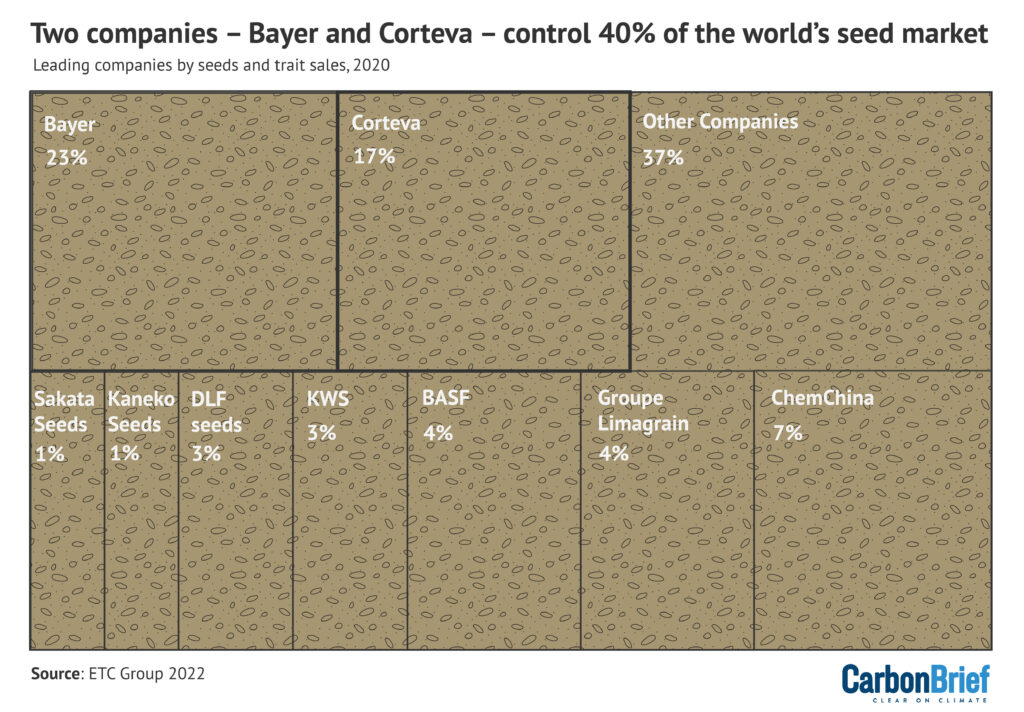
Petetin says that if seed patenting is permitted under the EU’s gene-editing rules, as currently proposed, it could lead to “more concentration of the seeds and the plant business”.
Experts tell Carbon Brief that the patenting of these seeds impacts farmers as they often have to re-purchase GM seeds each year from a company which has complete control over the cost.
The price of GM seeds rose by more than 700% between 2000 and 2015. A number of large seed companies have taken farmers to court for infringing on patent rights by growing GM crops without payment.
Patenting can also pose problems for small-scale seed developers, as similarities with patented crops can also lead to infringement claims. This can apply to both genetically modified and conventional crops.
Eva Corral, a GMO campaigner at Greenpeace EU, is calling for more information on the climate, health and environmental impacts of gene-edited foods and for labelling to remain in place in the EU’s rules.
She tells Carbon Brief that gene-edited crops are not a “panacea” to “miraculously solve all the problems in the world”, adding:
“We have to be really very, very cautious, which I think is something very much missing in the debate about new GMOs.”
Could gene-editing and GMOs benefit food security?
Whether through traditional breeding or by scientists in a lab, crops are often altered to make them more resistant to drought, better able to fight off disease or to improve their nutritional value.
All of these elements could be helpful for farmers around the world whose crops are being damaged by extreme weather conditions fuelled by human-caused climate change.
Disasters – such as floods, droughts and wildfires – have caused about $3.8tn worth of lost crops and livestock production over the past three decades, according to a report by the UN Food and Agriculture Organization.
Genetically modified crops can increase the amount of food grown in a certain amount of space – which is significant given that the amount of arable land around the world is declining.
Global crop production grew by more than 370m tonnes between 1996 and 2012. Genetically modified crops in the US accounted for one-seventh of this boost.
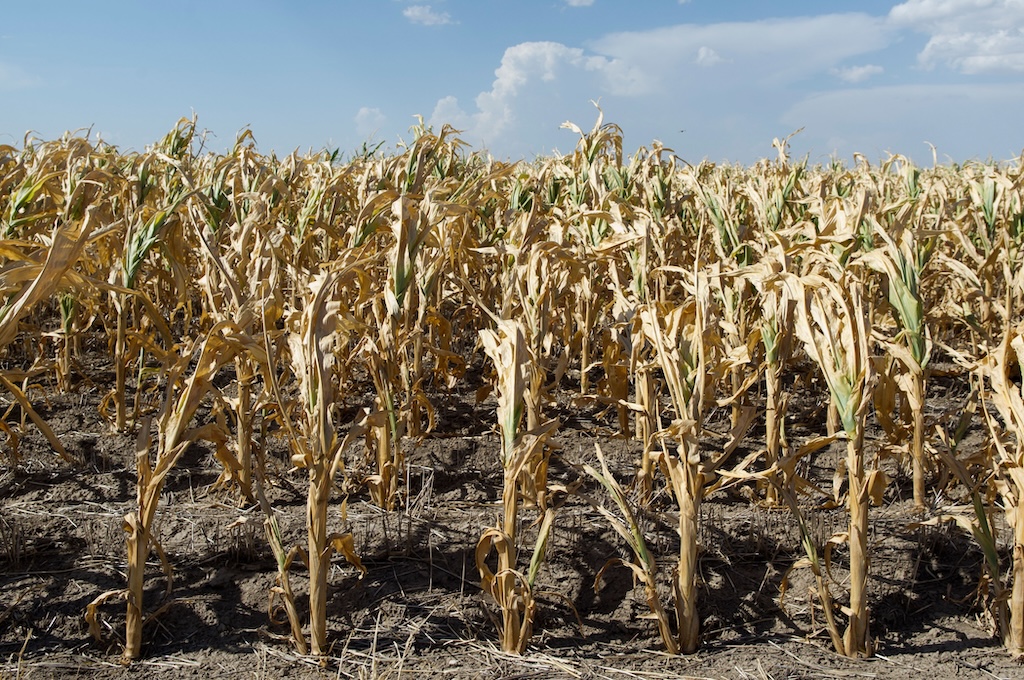
Increased crop yields and reduced losses due to extreme weather can be particularly attractive for countries hit by high levels of hunger and facing severe impacts of climate change.
Between 691 and 783 million people faced hunger in 2022, according to the UN’s 2023 report on food security and nutrition. The issue is particularly acute in Africa, where around one in five people face hunger – a “much larger” amount than the rest of the world, the report says.
Several experts tell Carbon Brief that scientists have long-hoped that Crispr’s relatively low cost and simpler technology would enable more gene-edited crop development in developing countries.
In African countries, GM and gene-edited crops could be part of the solution, but are not the only fix to problems facing agriculture, such as drought and poor crop yields, says Prof Ademola Adenle, a guest professor of sustainability science at the Technical University of Denmark. He tells Carbon Brief:
“Just like GMOs, gene-editing is not a silver-bullet solution to hunger or food security problems or climate change. But it could be part of a solution to a wide range of problems in the agricultural sector and [have] the potential to create crops that are resistant to diseases.”
Adenle, who is from Nigeria, has researched the progress in regulation and development of GM crops in different parts of Africa. GM crops are commercially grown in South Africa and a small number of other countries on the continent, such as Kenya and Nigeria.
He tells Carbon Brief that more research is needed to inform ongoing GMO and gene-editing discussions in African countries:
“Without investment in research and development programmes, Africa will be left behind…in terms of applying new technologies to solve some of the problems we have in the agricultural sector.
“Before gene-editing can be accepted in Africa, just like GMO, [countries] have to have the scientific capacity, they have to have the policy in place and, of course, they need to raise the level of awareness about the advantages and perhaps disadvantages that may be associated with the application of gene editing.”
Dr Joeva Sean Rock, an assistant professor in development studies at the University of Cambridge, has researched the politics of GM foods in Africa, particularly Ghana.
She says there is “a lot of hype” around the potential uses of gene-editing to develop crops that can “improve climate resilience and food security”. But she urges caution, telling Carbon Brief:
“An important question becomes how that hype compares with present reality…We are in a moment where there’s a real opportunity to ask not necessarily whether this technology could be a panacea, but rather if and how it might be able to benefit people at different scales and with different needs.”
A recent study found that a relatively small number of gene-editing crop projects focus on benefitting smallholder farmers in the global south. These farmers are “exceptionally vulnerable to climate change and food insecurity”, Rock says, adding:
“Farmers have diverse needs and so an important question is whether genome editing is an appropriate tool to address those needs and whether it is being used to do so.”
Do genetically modified crops benefit climate mitigation and adaptation?
There have been a lot of claims – and counter-claims – about the climate benefits of GMOs, both in terms of making crops more resistant to extreme weather and in helping plants to absorb more carbon from the atmosphere.
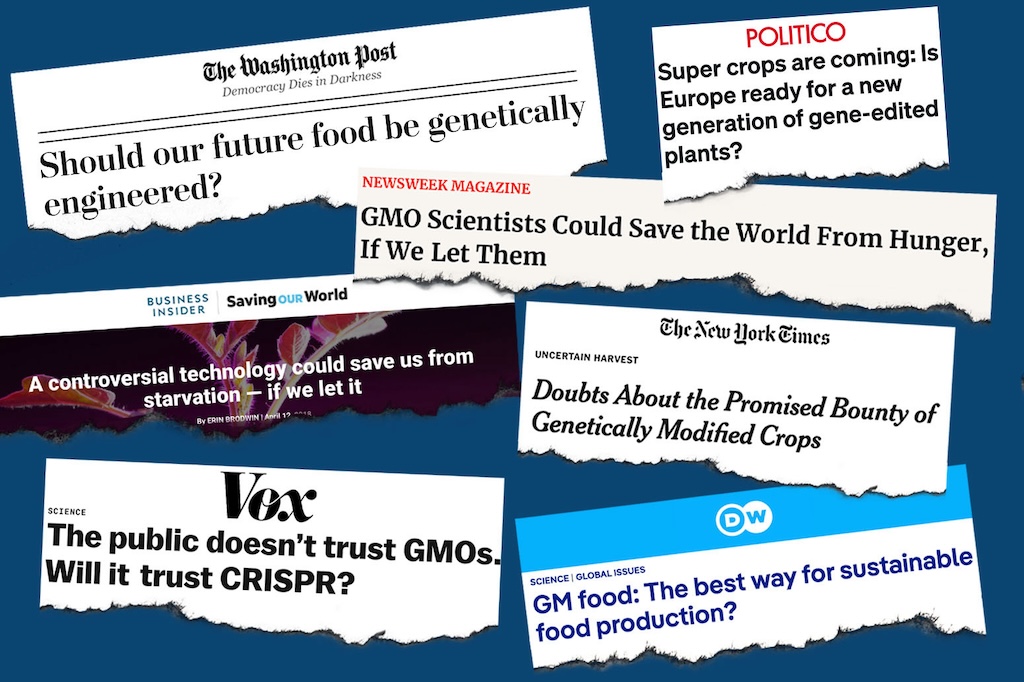
Dr Emma Kovak is a senior food and agriculture analyst at the Breakthrough Institute – a controversial thinktank in California that claims it “promotes technological solutions to environmental and human development challenges”.
Kovak was the lead author of a 2022 study which said that growing more GM crops, such as wheat, in the EU could lead to reduced land-use emissions in other parts of the world. The researchers estimated the extent that greenhouse gas levels would be impacted by the EU growing similar levels of genetically modified maize, soya beans, cotton, canola and sugar beet as the US.
The study claimed that this increase in EU GMOs would boost crop yields, which would allow the bloc to provide more of its own crops, Kovak tells Carbon Brief. This could lead to emissions cuts equivalent to more than 7% of the EU’s greenhouse gas emissions from agriculture, the study found. Kovak says:
“Expansion of crop production through yield increases in the EU can decrease farmland expansion in other places in the world, which means less deforestation and emissions from deforestation.”
Agriculture drives at least three-quarters of deforestation around the world, with forests cleared to raise animals and grow crops such as soya beans.
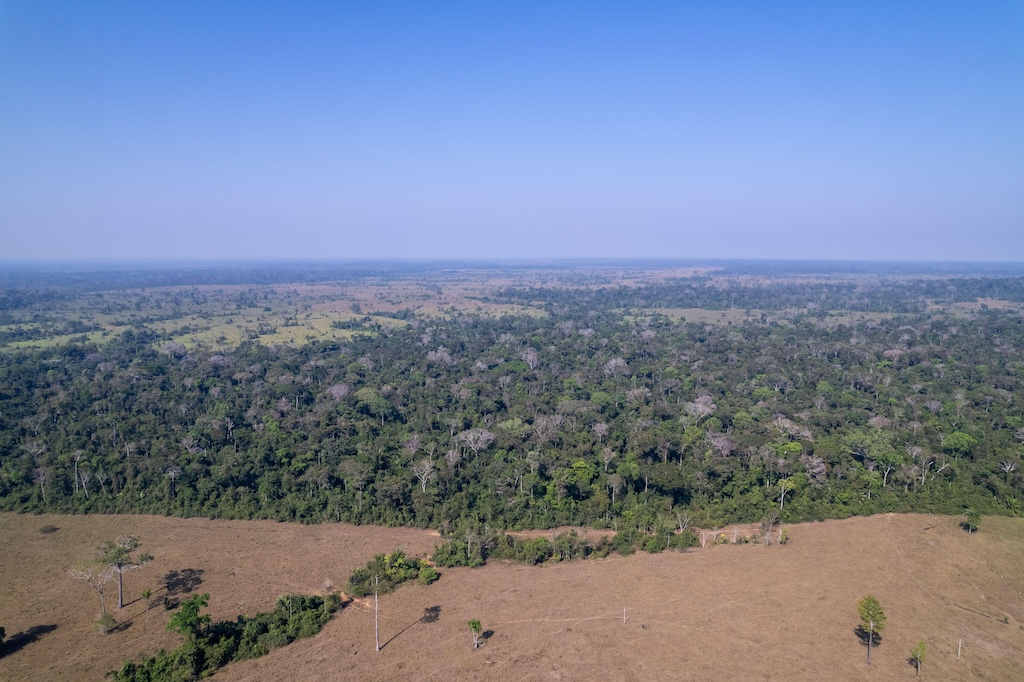
Another study published in 2018 looked at the environmental impacts of GM crops, such as maize, cotton and soya beans, on pesticide use and CO2 emissions across different countries over 1996-2016.
The study combined previous studies on fuel use and tillage systems – that is, preparing the land for crops – along with evidence on the impact of GM crop usage on these practices. It also looked at farm-level and national pesticide usage surveys.
It found that the use of GM insect-resistant and herbicide-tolerant technology reduced pesticide spraying by 8%. This, as a result, reduced the environmental impacts of herbicide and insecticide use.
It further led to cuts in fuel use and tillage changes, resulting in a “significant reduction” in emissions from areas growing GM crops. Combining figures from reduced fuel use and increased soil carbon storage, the researchers said the emissions reduction would be equivalent to taking almost 17m cars off the road for one year.
A 2011 review study found that GM crops could reduce the impacts of agriculture on biodiversity in a number of ways, such as by reducing insecticide use and boosting crop yields to ease the pressure to transform more land to grow crops.
A 2021 study found a correlation between GM crop growth and use of the herbicide glyphosate with an increase in soil carbon sequestration in a province of Canada. However, herbicide use decreased soil biodiversity in banana fields in Martinique, a Caribbean island, a different study found.
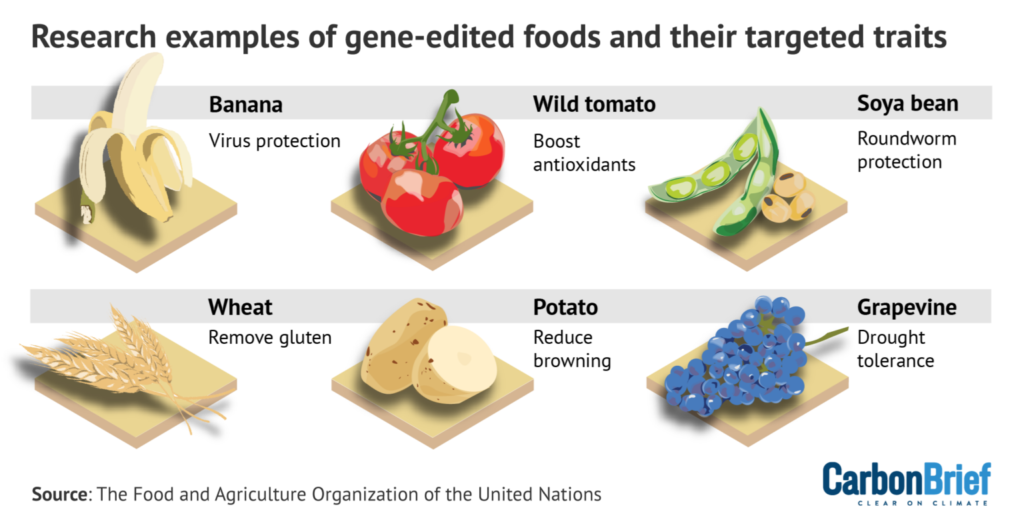
When it comes to gene-edited plants, experts tell Carbon Brief that more research is needed to determine the possible climate benefits or negative impacts.
Studies on gene-edited crops remain in the early stages of development.
In terms of boosting carbon sequestration through soils, whether it is through gene-editing or conventional breeding, Pett-Ridge says that definitive results are still some distance away. She tells Carbon Brief:
“There is a lot of hype…there are folks out there saying that this can solve everything or we can fix our climate issues with soils. I would push back on that, while still saying it’s a significant opportunity.”
Targeting certain traits through gene-editing will “take some time before we can really assess whether those have a net benefit on the amount of carbon put in soil”, she adds:
“As much as I’m an optimist and excited about it… I don’t know anyone who has got traits focused on carbon capture really being applied even in a field trial.”
Petetin believes gene-editing may “provide some answers” to help the agriculture sector deal with extreme weather and other issues, but adds:
“They’re not the only answers to all the issues agriculture is facing with biodiversity and climate change emergencies. Putting all your eggs in this one basket is not the solution.”
-
Q&A: The evolving debate about using genetically modified crops in a warming world





